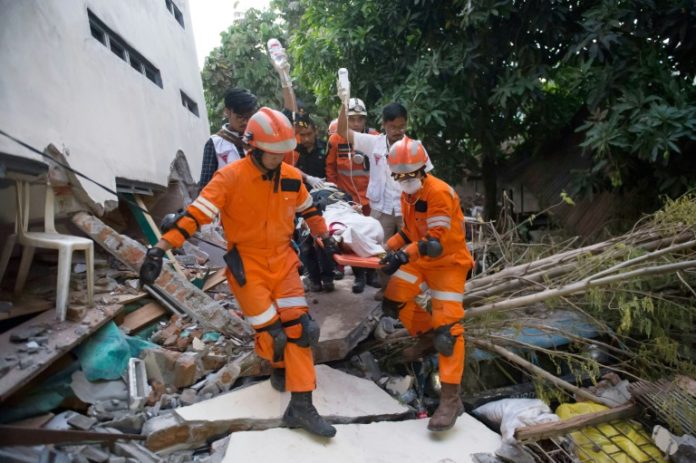PALU, Indonesia, Oct 1, 2018 (BSS/AFP) – Indonesian volunteers dug mass
graves for more than 1,000 bodies on Monday after a quake and tsunami
devastated swathes of Sulawesi, as authorities — struggling to deal with the
sheer scale of the disaster — appealed for international help.
Indonesia is no stranger to natural calamities and Jakarta wanted to show
that it was able to deal with a catastrophe that has killed at least 832
people so far according to the official toll.
But four days on some remote areas have yet to be contacted, medicines are
running out and rescuers are struggling with a shortage of heavy equipment to
reach desperate victims calling out from the ruins of collapsed buildings.
In response, President Joko Widodo opened the door to the dozens of
international aid agencies and NGOs lined up to provide live-saving
assistance.
“Last night, President @jokowi authorized us to accept international help
for urgent disaster-response & relief,” senior government official Tom
Lembong wrote on Twitter, asking rescuers to contact him directly via his
account and email.
Officials fear the toll will rise steeply in the coming days and are
preparing for the worst.
At Poboya — in the hills above the devastated seaside city of Palu —
volunteers dug a 100 metre-long grave to bury the dead, with instructions to
prepare for 1,300 victims to be laid to rest.
Authorities are desperate to stave off any disease outbreak caused by
decomposing bodies and have announced a 14-day state of emergency.
– Twisted wasteland –
In Balaroa, a Palu suburb once home to a housing complex, the scale of the
damage was apparent. A wasteland of flattened trees, shards of concrete,
twisted metal roofing, doorframes and mangled furniture stretched out into
the distance.
Dazed groups of people ambled over the wreckage, unclear where or how to
start digging. Among them were three men looking for their younger brother.
Rescuers are racing against the clock and a lack of equipment to save
those still trapped in the rubble, with up to 60 people feared to be
underneath one Palu hotel alone.
Two survivors have been plucked from the 80-room Hotel Roa-Roa,
Indonesia’s search and rescue agency said, and there could still be more
alive.
Desperate survivors turned to looting shops for basics like food, water and
fuel as police looked on, unwilling or unable to intervene.
“There has been no aid, we need to eat. We don’t have any other choice, we
must get food,” one man in Palu told AFP as he filled a basket with goods
from a nearby store.
The disaster agency said a tsunami warning system, which might have saved
lives, had not worked for six years due to a lack of money.
“Our funding has been going down every year,” agency spokesman Sutopo
Purwo Nugroho said.
Many have spent the last days desperately searching for loved ones while
dealing with the trauma of the disaster.
One survivor, Adi, was hugging his wife by the beach when the tsunami
struck on Friday. He has no idea where she is now, or whether she is alive.
“When the wave came, I lost her,” he said. “I was carried about 50 metres.
I couldn’t hold anything,” he said.
Others have centred their search for loved ones around open-air morgues,
where the dead lay in the baking sun — waiting to be claimed, waiting to be
named.
As dire as the situation in Palu is, it was at least clear. In outlying
areas, the fate of thousands is still unknown.
Indonesia’s Metro TV broadcast aerial footage from a coastal community in
Donggala, close to the epicentre of the quake. Some waterfront homes appeared
crushed but a resident said most people fled to higher ground after the quake
struck.
“When it shook really hard, we all ran up into the hills,” a man
identified as Iswan told the TV.
– Ports, bridges, roads shattered –
Yenni Suryani, of Catholic Relief Services, said devastated infrastructure
was hampering rescue efforts.
“Humanitarian groups are struggling to get people into affected areas,”
she said. The main airport at Palu was damaged, landslides had cut off key
roads while “power is out almost everywhere,” she added.
Satellite imagery provided by regional relief teams showed severe damage
at some of the area’s major ports, with large ships tossed on land, quays and
bridges trashed and shipping containers thrown around.
A double-arched yellow bridge had collapsed, its ribs twisted as cars
bobbed in the water below.
Indonesia, home to 260 million people, is one of the world’s most
disaster-prone nations.
It lies on the Pacific “Ring of Fire”, where tectonic plates collide and
many of the world’s volcanic eruptions and earthquakes occur.
A massive 2004 quake triggered a tsunami that killed 220,000 throughout
the region, including 168,000 in Indonesia.



